The Samsung Galaxy Note5 and Galaxy S6 edge+ Review
by Joshua Ho on October 2, 2015 8:00 AM ESTBattery Life
Battery life is undoubtedly one of the most important parts of the user experience of any mobile device. One of the major reasons why many people use phablets is to get better battery life, as the PCB size of a phablet is often roughly similar to what you’ll see in a smartphone, but the battery will be bigger to fill the available space. As a result, a phablet has a higher proportion of battery than a smartphone. This inherently means that battery size will scale faster than platform power. In order to test this metric, we use a number of different tests ranging from display-bound web browsing to SoC-bound CPU and GPU load tests. In order to eliminate confounding variables, we test all devices from the same ASUS RT-AC68U router for WiFi testing, and in strong LTE/3G reception for mobile web browsing, in addition to setting all devices to an average of 200 nits on the display.
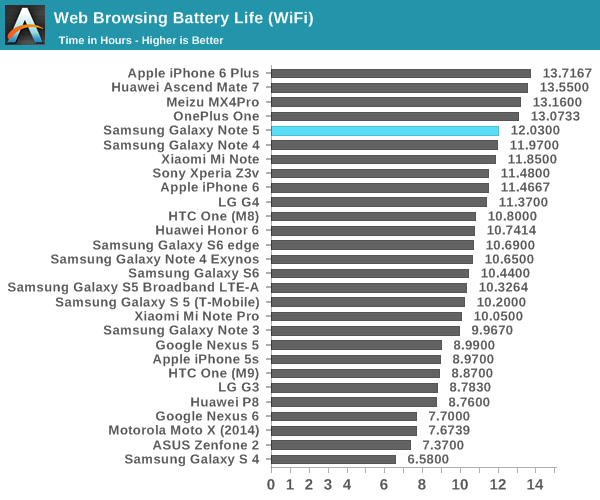
In our first test of WiFi web browsing, the Galaxy Note5 performs identically to the Galaxy Note 4. This might be surprising because the display is the same size and resolution as the Galaxy Note 4 with a smaller battery than the Galaxy Note 4. However, the smaller battery is compensated for due to improvements in SoC and display efficiency. In particular, the move from a planar 28nm process to a 14nm FinFET process dramatically reduces power consumption on the SoC.

In LTE battery life, we see a noticeable drop relative to WiFi battery life. It’s likely that this is mostly due to the power consumption of the Shannon 333 modem present in these devices. There’s not much else to say here, but battery life is still good.
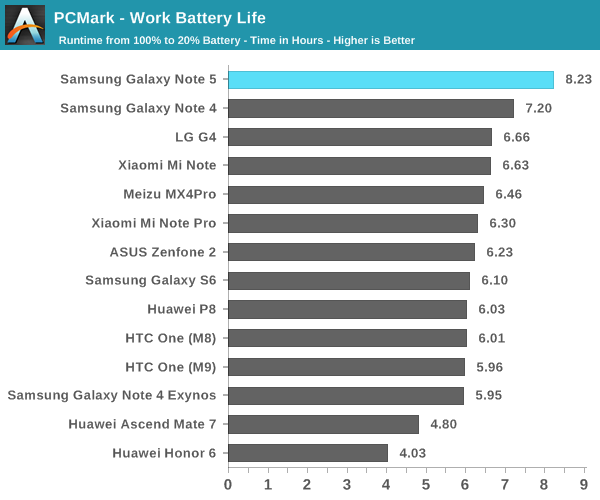
Moving past our mostly display-bound web browsing test, PCMark provides a much more balanced look at battery life as APL tends to vary a bit more with content like videos and photos instead of just webpages, and the CPU component is much more strongly emphasized. Here we can really see the Note5’s Exynos 7420 stretch its legs as it keeps a high performance level with long runtime.
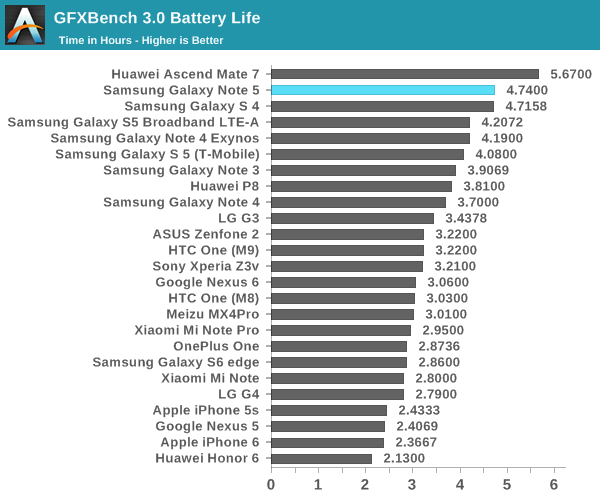
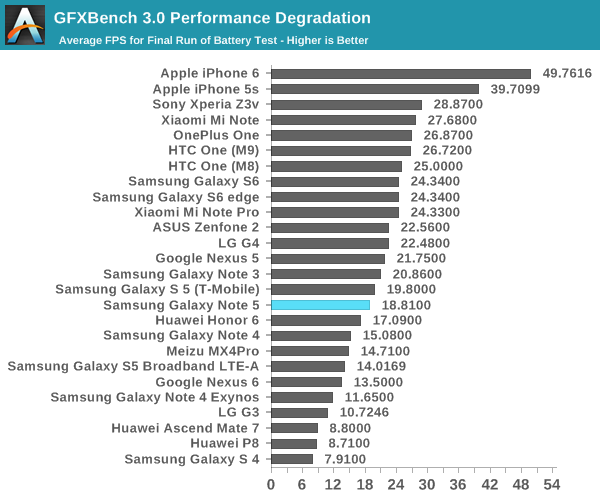
In our sustained SoC-bound workloads, GFXBench shows a healthy improvement over the Galaxy S6. Although we’re unable to test in perfectly controlled temperatures, it looks like Samsung has improved the throttling behavior of the SoC as the throttling appears to be more graceful rather than sinusoidal, and the result is a pretty significant jump in runtime over most devices.
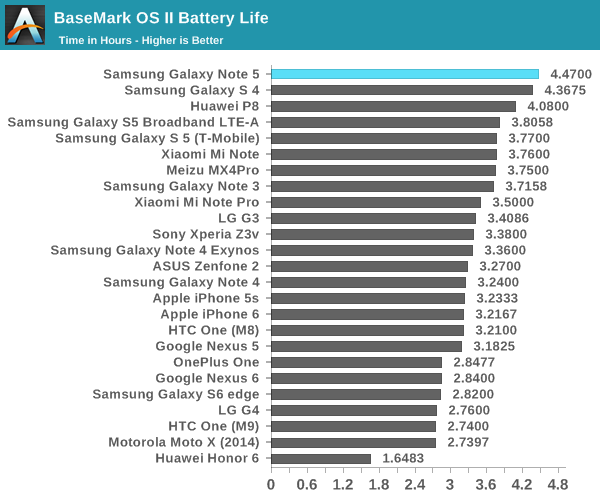

In Basemark OS II, we see a pretty significant uplift in runtime when compared to something like the Galaxy S6 or Note 4. The runtime increase isn’t just due to excessive throttling though, as the battery score shows that this isn’t just a case of throttling the CPU until the runtime is an improvement over past devices.
Overall, if you’ve read the Galaxy S6 review it’s pretty fair to say that you’ll know what to expect from the Galaxy Note5. Battery life is roughly equivalent to the Galaxy Note 4 despite the smaller battery, and due to the greatly improved Exynos 7420 SoC relative to 2014 SoCs SoC-bound cases will show pretty healthy improvements as long as you’re controlling for performance.
Charge Time
While normally battery life is the primary area of concern for a smartphone, in some cases it’s important for a phone to charge quickly. We can all claim to be perfect but one of the simplest cases for faster charging is forgetting to plug the phone in before going to sleep, so the maximum allowable charge time goes from something like 6 hours to an hour at best. As a result, a faster charger can dramatically improve practical battery life in any situation where you have limited time to charge. This can be accomplished by increasing either the current or voltage of the charger. The original quick charging standards improved charge rate through higher current, but this eventually hits a wall due to resistance in the wire. In order to increase the total amount of power delivered without increasing the thickness of the cable used voltage was increased in the case of newer standards like QC 2.0. In the case of the Galaxy Note5 and Galaxy S6 edge+, we’re looking at the same 9V, 1.67A QC 2.0 compatible charger that shipped with the Galaxy Note 4. In order to test this properly, we log the time it takes for the phone to charge by running a timer until the charger power draw hits a point that represents 100% battery.
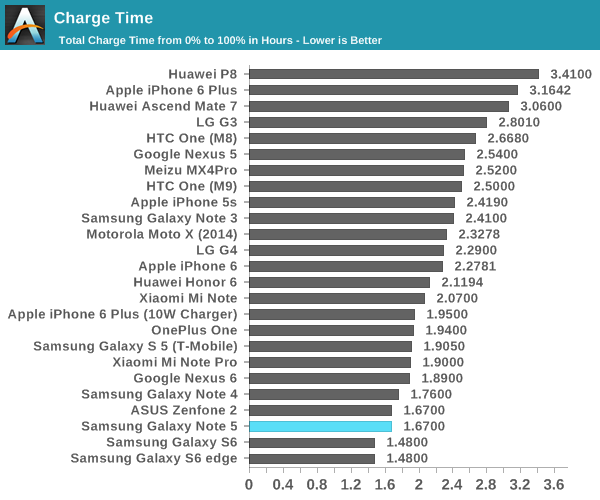
It probably isn’t a surprise, but charge time ends up similar to the Galaxy S6 and Galaxy Note 4. I suspect that we’ll be waiting until QC 3.0 to be able to see significant improvements as the current standard doesn’t have particularly fine-grained voltage scaling according to cable and phone conditions. Interestingly, the wireless fast charger is actually not too far off from the wired charger as it indicates 100% around 1.84 hours into charging which is almost identical to the wired fast charger.


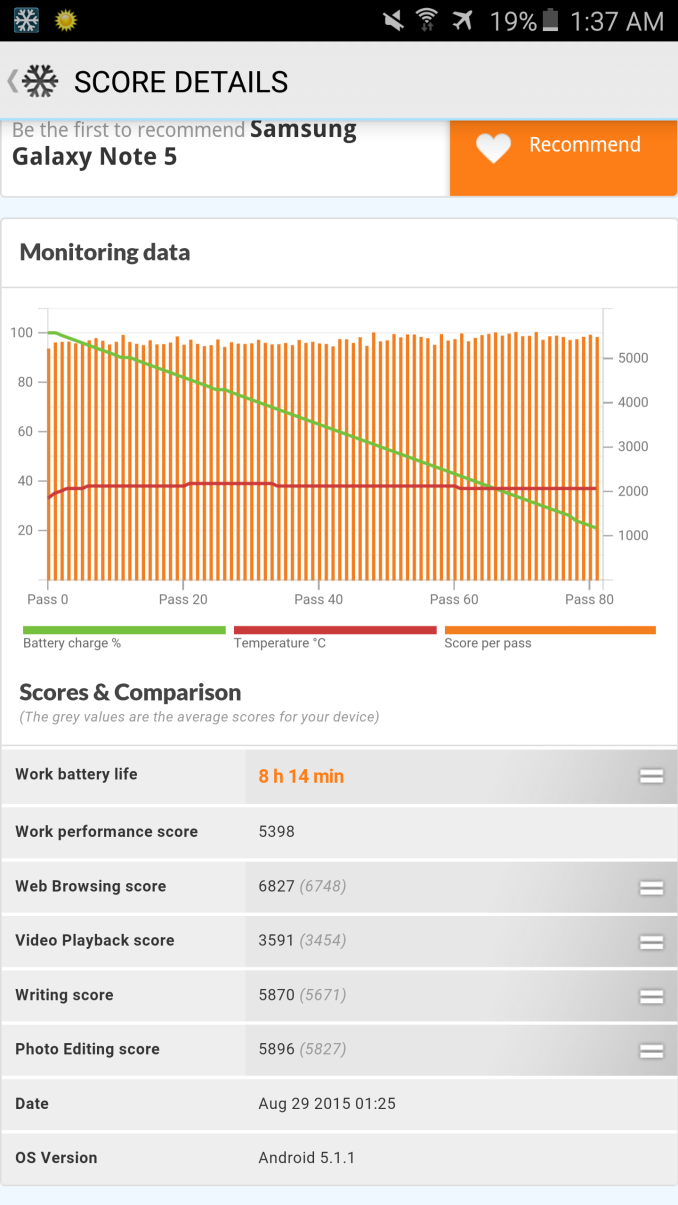
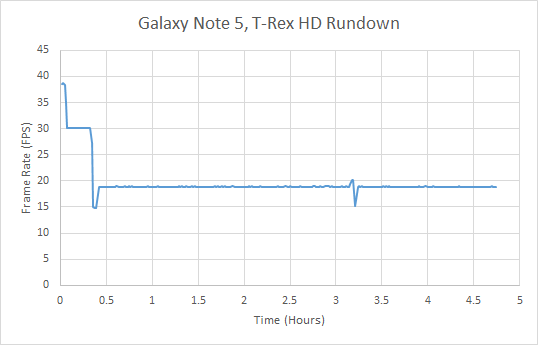
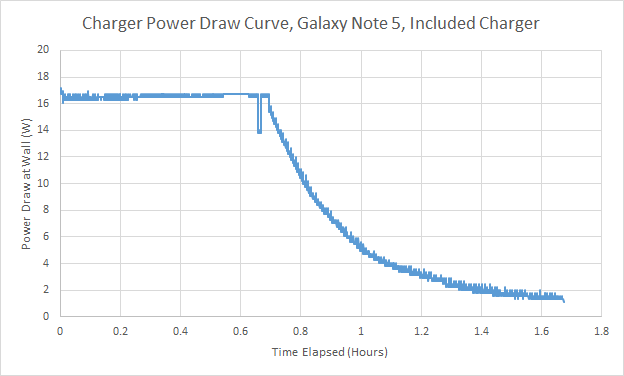
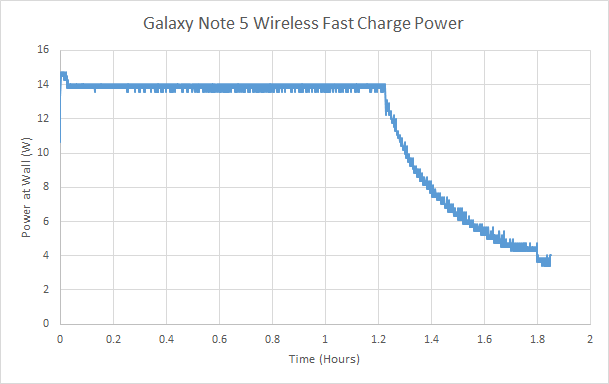








225 Comments
View All Comments
lopri - Friday, October 2, 2015 - link
Also odd that the author thinks the color shift on the Edge+ is due to RGBG subpixel layout. I thought the color shift would be there due to curves regardless of subpixel layout.In any case I give the author props for this effort. A rather thorough review, even if a little heavy on editorials.
lilmoe - Friday, October 2, 2015 - link
After being called out so many times, your "comparison charts" are still an absolute (intentional?) mess. Why do you have 25 different phones on one chart, and 10 completely different ones on others? Why is the crappiest browser on Android still being used for battery tests? Why is the iPhone 6 in GPU tests and the 6plus absent?While they do have really nice articles, Anandtech scores the lowest in the consistency department out of all sites. Please try being more consistent.
Can you just put 4-5 most popular phones of each platform on the SAME darn charts and keep them that way, without conveniently leaving some out and putting them back here and there? Like PLEASE?
Also, it would be nice if you'd explain why you're posting NAND performance benchmarks with your particular set of settings. I seriously find it VERY hard to believe that UFS 2.0 is equal or often slower than the very best of eMMC in sequentials and randoms.
lopri - Friday, October 2, 2015 - link
The real mess is the camera samples. (which by the way is not limited to Android devices for a change) It is maddening to sift through camera samples without knowing ahead what I am going to see only to click dozen more times to find out what I am looking for.Kuzi - Saturday, October 3, 2015 - link
Agreed their charts are a mess.Bob Todd - Friday, October 2, 2015 - link
The gigantor phone market is more competitive than ever, so it's interesting to see them dropping features and generally not taking full advantage of being the most vertically integrated Android OEM. They dropped microSD but capacity maxes out at 64GB. They had the opportunity to be ballsy and go higher capacity PCIe NVMe and absolutely crush every other Android OEM in storage performance. You have to *really* want the pen, because this looks like a tough sell at $780 for 64GB when $650 gets you a 128GB Nexus 6P and $500 gets you a 64GB Moto X Pure with expandable storage. Sure Samsung's SOC is better, but this is a pretty underwhelming release for me.TheinsanegamerN - Friday, October 2, 2015 - link
Not to mention the sealed, non removable battery. And samsung's terrible track record with updates.thedons1983 - Sunday, October 18, 2015 - link
Sealed, non removable battery = better looking device. Simple as. Never mind the fact, that most users do not want to swap the battery, as they simply don't need to. How obsessed with your phone are you anyway? You should probably try getting a life instead!!lilmoe - Friday, October 2, 2015 - link
Samsung knows a thing or two about fast storage, and their UFS 2.0 is pretty darn GOOD. It's just not showing well on you-know-who's charts.Bob Todd - Friday, October 2, 2015 - link
You are missing the point. They are charging more than "good enough" money for this thing. They need to offer compelling reasons to spend way more on this than the other solid new entries in this segment. Something like a PCIe NVMe solution would have been a good way to justify that price gap. I predict steep discounts (~$100+) shortly after launch.lilmoe - Friday, October 2, 2015 - link
"I predict steep discounts (~$100+) shortly after launch"They already priced the Note 5 cheaper than the Note 4 at launch. Sorry if American carriers are over charging.
"You are missing the point"
Read my *short* comment again. Their storage solution isn't particularly inferior. Random reads and writes are comparable, if not better. If you honestly believe that sequential performance is more important than random for everyday workloads, then I have nothing else to tell you. It's not like we have an extensive comparison of performance and power consumption/efficiency between Samsung's UFS 2.0 vs Apple's sourced NVMe solution (might not even be possible at this stage), nor is it the case that Samsung has already developed a miniature PCIe V-NAND 950 PRO NVMe SSD and is holding back to "cut corners".
Everything in this segment is overpriced, for better or worse. We just learn to "deal with it". That said, your point boils down to overall manufacturer costs, ie: BoM. You shouldn't make assumptions on your own over bits and pieces of the package. Samsung, despite manufacturing most of their parts, have a costlier BoM than most other OEMs, including Apple. Their external enclosure, AMOLED screens, Wacom Digitizers, DACs, etc. are always best in class and cost more than comparable parts from the competition. Other than the omission of SD-card controller, they went all out in every other detail (removable batteries don't contribute to cost, it's a design choice rather).
That said, I'd rather have them start with 64GB of standard storage (128GB option) and an SD-Card slot for a much more value proposition at that price range. A larger ~4000mah battery would have also been possible since the Note 5 is relatively large but is one of the lightest "phablet" out there. This goes for all manufacturers, not only Samsung.